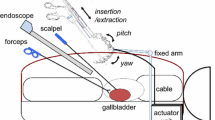Abstract
Mechanical support system is needed for minimally invasive surgery, since it enables precise manipulation of surgical instruments beyond human ability in a small operation space. Furthermore, a robot available for intraoperative MRI guided neurosurgical procedures could allow less invasive and more accurate image guided surgery. By combination of precise positioning to the target by intra-operative MRI guided surgery and dexterity by the multi function micromanipulator, safe and smooth operation is expected to be performed. In this approach, we have developed MR-compatible micro-forceps manipulator of the multi-function micromanipulator system for neurosurgery. By a new cam mechanism for two degrees of bending freedom, we achieved these excellent characteristics for the micro forceps. 1) Simple mechanism suitable for a micromanipulator, 2) Precise positioning, 3) Suitable mechanism for MR compatible manipulator. By evaluation experiments, we confirmed precise positioning of the manipulator and MR compatibility of the manipulator.
Chapter PDF
Similar content being viewed by others
Keywords
These keywords were added by machine and not by the authors. This process is experimental and the keywords may be updated as the learning algorithm improves.
Reference
Salisbury J.K.: The heart of microsurgery, Mechanical Engineering, v. 120 n. 12 Dec p46–51 (1998)
Mitsuishi M. et al,: A tele-micro-surgery system with co-located view and operation points and a rotational-foce-feedback-free master manipulator, Proc. of MRCAS’ 95, pp. 111–118, (1995)
Berkelman P.J. et al: A Miniture instrument tip force sensor for robot/human cooperative microsurgical manipulator with enhanced force feedback, MICCAI2000, Proc. pp. 897–906 (2000)
Schurr M.O. et al.: Robotics and telemanipulation technologies for endoscopic surgery, Surgical endoscopy, 14, pp. 375–381, (2000)
Kan K., et al.: Microscopic-manipulator system for minimally invasive neurosurgery, Proc. of CARS 98, pp. 594–598, (1998)
Harada K. et al.: Development of a micro manipulator for minimally invasive neurosurgery, Proc. of CARS 2000, pp. 116–120, (2000)
K Masamune, M Sonderegger, H Iseki, K Takakura, M Suzuki, T Dohi, Robots for Stereo-tactic neurosurgery, Advanced Robotics, Vol. 10, No. 3, pp. 391–401 (1996)
Hwa-shain Y, et al.: Implantation of intracerebral depth delectrodes for monitoring seizures using the Pelorus stereotactic system guided by magnetic resonance imaging, J Neurosurg 78:138–141, (1993)
Robert B. Lufkin: Interventional MRI, pp. 55–69, Mosby, (1999)
Chinzei K., Hata N., et al.: MR-compatible surgical assist robot: system integration and preliminary feasibility Study, IEEE/RSJIROS2000, Proc. 727–732 (2000)
Masamune K., Kobayashi E., et al.: Development of an MRI compatible needle insertion manipulator for stereotactic neurosurgery, J Image Guided Surgery, 1 pp. 242–248 (1995)
Chinzei K., et al.: Surgical assist robot for the active navigation in the intraoperative MRI, MICCAI2000, Proc. pp. 921–930 2000
Author information
Authors and Affiliations
Editor information
Editors and Affiliations
Rights and permissions
Copyright information
© 2002 Springer-Verlag Berlin Heidelberg
About this paper
Cite this paper
Miyata, N. et al. (2002). Micro-grasping Forceps Manipulator for MR-Guided Neurosurgery. In: Dohi, T., Kikinis, R. (eds) Medical Image Computing and Computer-Assisted Intervention — MICCAI 2002. MICCAI 2002. Lecture Notes in Computer Science, vol 2488. Springer, Berlin, Heidelberg. https://doi.org/10.1007/3-540-45786-0_14
Download citation
DOI: https://doi.org/10.1007/3-540-45786-0_14
Published:
Publisher Name: Springer, Berlin, Heidelberg
Print ISBN: 978-3-540-44224-0
Online ISBN: 978-3-540-45786-2
eBook Packages: Springer Book Archive




